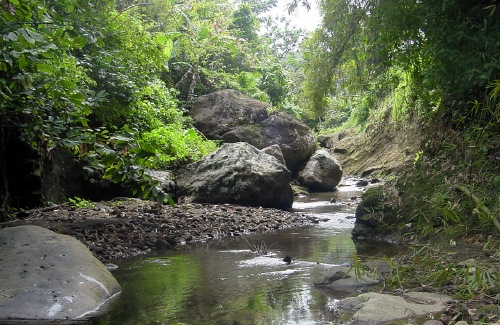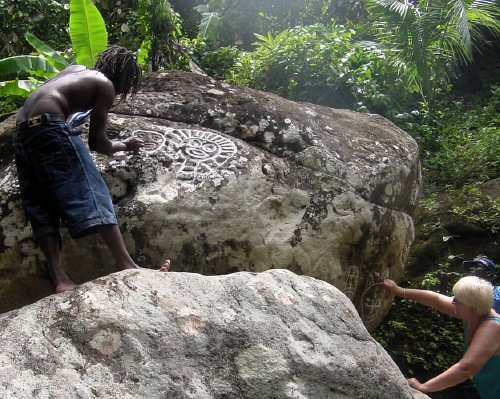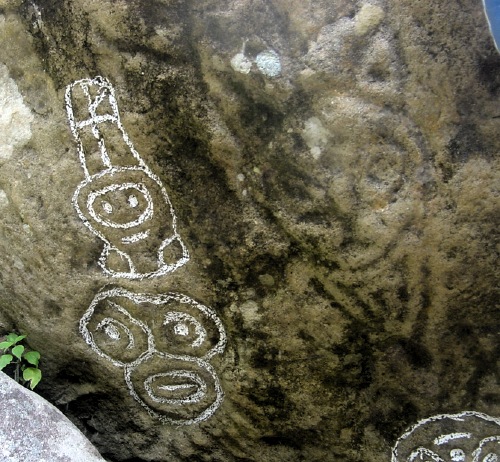The Kalinago of Grenada
By Margaret
Hughes
We call them Carib, Arawak, Siboney. They
called themselves Kalinago. These early Grenadian
inhabitants, from around the time of Christ to 1650 AD
(approx), unfortunately, have been largely forgotten, and
their story has been overwritten by European colonisers.
A glimpse into the lives of these
interesting ancestors was provided by Dr.
Lennox Honeychurch, a
distinguished Caribbean anthropologist from Dominica when he
visited Grenada at the invitation of Mrs. Beverley Steele,
Resident Tutor, UWI, School of Continuing Studies in January
last. His visit generated great interest and contributed
widely towards an appreciation of the important heritage
left us by the Kalinago. Dr. Honeychurch spent ten days
here. He spoke to artists, teachers, students, local
organizations and the general public both in Grenada and in
Carriacou.
A tour of Kalinago sites, supervised by
Dr. Honeychurch, was taken by many Grenadians and evoked
enthusiastic expressions of appreciation. Some told me "the
trip revealed how fortunate we are to have this rich
heritage". Others said,"the only perspective I had of our
history was the European one. Now, I have another" and "the
Caribbean is one of the most diverse regions in the world"
In Carriacou, after a tour of sites, the
school children and teachers returned to listen to a
lecture. Gertrude Simon, who hosted the Carriacoun visit ,
reported, " Dr. Honeychurch's visit can be summed up in
words of local participant, Raul Paterson, "I knew the
lecture was a success, when I saw it was after seven and the
people were still listening." Gertrude Simon continued,
"because of the impact, we are hoping to invite him back.
People who could not attend, now want to hear him"
Dr. Honeychurch delivered a lecture with
slide show to 40 students and artists at T.A. Marryshow
College. Reporting this interesting event, artist Susan
Mains says all were eager to hear of the potential of
incorporating the spirit of our Kalinago heritage into the
language and presentation of the visual arts. "Dr.
Honeychurch's focus gave meaning to the figures used by the
Kalinago," she said, "these all carry iconology which can be
incorporated into the visual arts, and there was a lively
discussion about making art, not only as a souvenir item
sold to tourists, but for cultural enrichment."
Peter Antoine, who organized the
Grenville visit, reports it was a great success. The
atmosphere in the "Old Church" was intimate, he said, and
the audience was enthusiastic. The evening was hosted by the
Grenada Education and Development Programme (GRENED) and St.
Andrews Development Organization (SADO) and a report by
Charles Boehm of Grened, not only covered this session, but
captured the essence of Dr. Honeychurch's visit to Grenada.
"Dr. Honeychurch started by noting the proximity to Pearls,
on Grenada's Eastern Coast which he described as 'the most
important archeological site in the Caribbean. This area was
a major stopping point for the Kalinago nation as they
travelled northward from the Orinoco River basin in South
America. As the southernmost of 'volcanic Caribees,' a
geological term for the Windward Islands, Grenada was
central to 'the peopling of the Caribbean.' "
The Kalinago were drawn to Pearls by its
rich soil, fishing, and natural resources. They arrived with
agriculture and pottery skills. Honeychurch described their
close connection to the earth and its subsequent effect on
their worldview. The Kaninago religion was based on the
seasons and their cyclical patterns. Winter and summer
equinox were carefully tracked, as were rainfall levels,
because the wet and dry seasons were critical for life. The
dry season was considered the men's domain, because their
skills of hunting and gathering were in demand at this time.
This was represented in pottery and other art by the bat, a
creature which was more prevalent during the dry months and
bore more male characteristics (aggressive, restless,
migratory). Conversely, the wet season was regarded as
'feminine' in nature, a fertile time for growing crops and
maintaining stability. The frog was identified with these
qualities and thus figures prominently in petroglyphs and
pottery designs.
Other symbols commonly used by the
Kalinago included owls (representing the underworld)
manatees (once inhabitants of Grenada's bays and inlets),
simple face designs, suns, moons, and cosmological figures.


Petroglyphs, such as the ones found near
Mt. Rich, in the North of the island, are a major legacy of
the Kalinago. These rock carvings seem to be placed
symbolically, possibly to catch the sun's rays and measure
seasonal progress. Unfortunately, modern scholars know
little about their true meaning. Honeychurch made an
interesting point on this issue by comparing Kalinago images
to modern symbols such as signs for men's/women's restrooms,
traffic signs, etc. We take them for granted on a daily
basis because they are basic communicators of meaning within
our culture. Once removed from their original context, they
are just as baffling to outsiders as the Kalinago
petroglyphs are to us.

Dr. Honeychurch also touched on the topic
of ethnobotany, which seeks to learn more about a culture
through its use of plants and vegetation. While many of
Grenada's most popular crops such as mango, breadfruit, and
banana were imported during the colonial era, others have
been here for millennia and were important to the Kalinago.
Sugar apple, or lakikili, has been in Grenada for over 2000
years; the Kalinago boiled its leaves to make a tea for
spleen pain. Such medicinal knowledge mingled with similar
African know-how when slaves began arriving in the islands,
still exists today. The cassava, or manioc, was a vital
staple for Kalinago, as was the tannia, or taya, and the
soursop. The reedy rosear plant, referred to as ariboo, was
crucial to the Kalinago. Its fronds were thatched to create
an effective roofing material for their huts, while arrows
were made from its stalks. If the tribe was going to war,
the fishbone arrowheads might be dipped in poisonous
manchineel sap.

Also very important was the conch: its
meat provided sustenance, while the shell was versatile. It
could be sharpened into a blade or axe by grinding on
volcanic stone - like the one at Grand Mal or Telescope,
where a former Kalinago grinding stone is now called "Knife
and Fork Rock." Conch shells also served as a sort of
three-dimensional map, as their features mimicked the
mountainous terrain of the Windward Island.
Honeychurch entertained the participants
with several examples of Kalinago folk tales. As with all
religions, their purpose was to create order in society.
Thus, the story that explains the origins of the
"man-in-the-moon" in which a father must flee the earth
after a doomed romance with his daughter, also discourages
incest. The Kalinago explanation for the Orion and Seven
Sisters constellations centres on a pair of star-crossed
lovers, while other tales confirm the existence of flora and
fauna such as the crested hummingbird.
Further signs of the Kalinago lifestyle
are the craft of canoe building with practitioners today in
Dominica and St. Lucia hand-carving boats out of a single
tree trunk. Linguistic contributions of the Kalinago exist
in our language such as hurricane which comes from their
word oorakan, while their term hamak is the ancestor of our
"hammock" kayak has remained unchanged.
The prevailing currents of the Caribbean
basin, especially from the Orinoco River, strongly
influenced indigenous migration. When asked why the Kalinago
left South America and migrated north in the first place,
Honeychurch answered with the analogy; why do West Indians
move to England? Answer; to find opportunity and improved
economic prospects, "just as it was for the previous
inhabitants of our islands."
Wonderful new horizons were opened up on
the history of the Grenadian ancestors during Heritage Week.
As the saying goes "you don't know where
you are going, if you don't know where you are coming from"
and these new horizons opened up for us an important and
exciting vista. But, where will we go from here ? Will we
preserve these priceless artifacts, petroglyphs, pottery and
locations ? They are important to us not just as a tourist
attraction. They are priceless jewels of our heritage and
must be preserved. They enhance our environment. They inform
and delight, giving us and our children a historical link
with the past and a truly Grenadian identity.
1st March 2003
About "Grenada's Story:"
This website is a work in progress, and we ask your
help in making it more and more useful in restoring heritage
resources available to the people of Grenada. Give us
feedback on what you find here---AND on what you WANT to
find by sending us an e-mail (click
HERE), or call (473) 440-2538, or WRITE to us at
Post Office Box 65, St. George's, GRENADA.
|